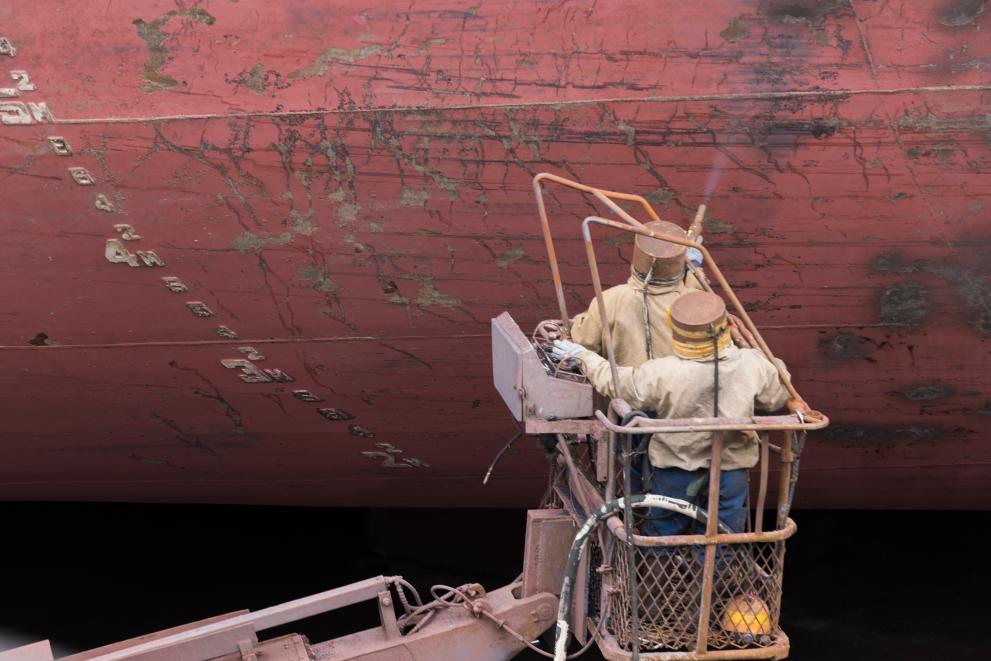
Commonly used copper-based biocidal hull coatings are toxic to non-target organisms and can pollute marine areas. This study tested a much less toxic silicone-based coating for suitability on vessels in the Baltic Sea.
The Baltic Sea is a heavily trafficked semi-enclosed sea, with around 2 000 ships within its borders at any given moment and a slow – 30-year – water-exchange cycle. Shipping traffic is set to increase as part of the shift from road to sea transport in Europe over the coming years. Leisure boats are also common in the Baltic, with Finnish and Swedish boat parks housing almost 2 million vessels. A recent study found that copper-based antifouling coatings on ship hulls in the Baltic Sea are the single largest anthropogenic contributor of copper pollution, making up one third of the load. It is important to reduce the use of copper-containing antifouling paints on waterborne vessels in the region, to minimise environmental contamination from toxic leachable pollutants.
The use of antifouling coatings that contain one or more toxic substances to repel or poison organisms can affect non-target marine organisms as well. It is important to prevent the fouling of hulls in the Baltic Sea, but to do so without polluting the marine environment. This research assessed the efficacy and environmental sustainability of a silicone-based foul-release coating (FRC), and the market barriers to using it, to evaluate if it could be a viable alternative to the copper-based coatings currently in widespread use. The results of this research could inform a transition to a product which lowers the environmental impact of shipping.
To compare the performance of a silicone FRC with copper-based biocidal coatings, 15x15cm PVC panels were painted and left exposed in the sea for one year. The panels were placed at three marine research stations along the Swedish coast, with one location in the Baltic Sea and two locations in Skagerrak (which connects to the North Sea). Two different copper-based biocidal coatings were used, as well as a non-biocidal coating to act as a control, for comparison with the silicone-based FRC. The panels were attached to a metal frame and submerged 1.5m below the surface of the sea in July 2020. The panels were photographed once a month to enable a later visual assessment of the images for amount of fouling present. The researchers used the naval ships’ technical manual (NTSM) fouling scale, which is from 0–100, with 0 representing no fouling, 10–30 soft fouling (e.g. various types of algae), and 40 and above representing hard fouling (e.g. calcareous fouling by bryozoans, commonly known as moss animals).
A literature review of different types of silicone FRCs on the market was conducted to assess viability from an environmental perspective. Two aspects of silicone FRCs were searched for in the literature: its toxicity to aquatic organisms in comparison to copper coatings, and the chemical nature and potential environmental hazard of leachable substances. To understand market barriers in the Baltic Sea region, the researchers interviewed representatives of the only local company at the time that was manufacturing coatings of this type for both the ship and leisure boat markets. Since the research was conducted another company locally has launched a silicone coating for boat hulls. The silicone-based coating performed as well as, or better than the copper coatings at all three sites. The silicone FRC is a viable alternative for both ships and leisure boats in the Baltic Sea, and is commercially available, so the authors say its use should be considered.
However, the study found that there is a large variety of formulations of silicone FRCs currently on the market, and that some of these are more toxic than others. Additionally, they can contain leachable substances such as silicone fluids which may persist in the environment. Further research is thus warranted on silicone FRCs; however, biocide-free FRCs are, overall, comparably much less toxic than the copper-based coatings used presently. The researchers suggest that the potential cost savings would be a key driver for uptake among ship owners; however, for leisure boat owners not driven by profit, uptake may be more problematic. In this regard, the authors suggest tighter regulation may aid a transition to the use of silicone FRCs, encouraging more companies to launch biocide-free silicone coatings for leisure boats. However, a legal framework should be set for FRCs, so selected (less toxic) biocide free silicone FRCs can be safely used, preferentially , over more toxic copper-based solutions.
Source:
Lagerström, M., Wrange, A.-L., Oliveira, D. R., Granhag, L., Larsson, A. I., and Ytreberg, E. (2022) Are silicone foul-release coatings a viable and environmentally sustainable alternative to biocidal antifouling coatings in the Baltic Sea Region? Marine Pollution Bulletin, 184: 114102. Available at: https://doi.org/10.1016/j.marpolbul.2022.114102.
To cite this article/service:
“Science for Environment Policy”: European Commission DG Environment News Alert Service, edited by the Science Communication Unit, The University of the West of England, Bristol.
Notes on content:
The contents and views included in Science for Environment Policy are based on independent, peer reviewed research and do not necessarily reflect the position of the European Commission. Please note that this article is a summary of only one study. Other studies may come to other conclusions.
Details
- Publication date
- 24 May 2023
- Author
- Directorate-General for Environment

